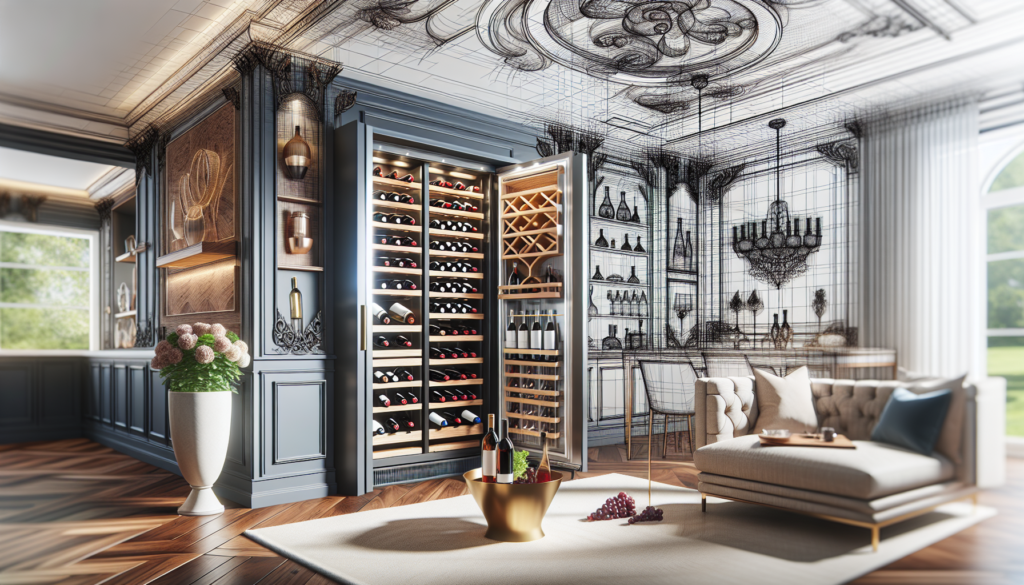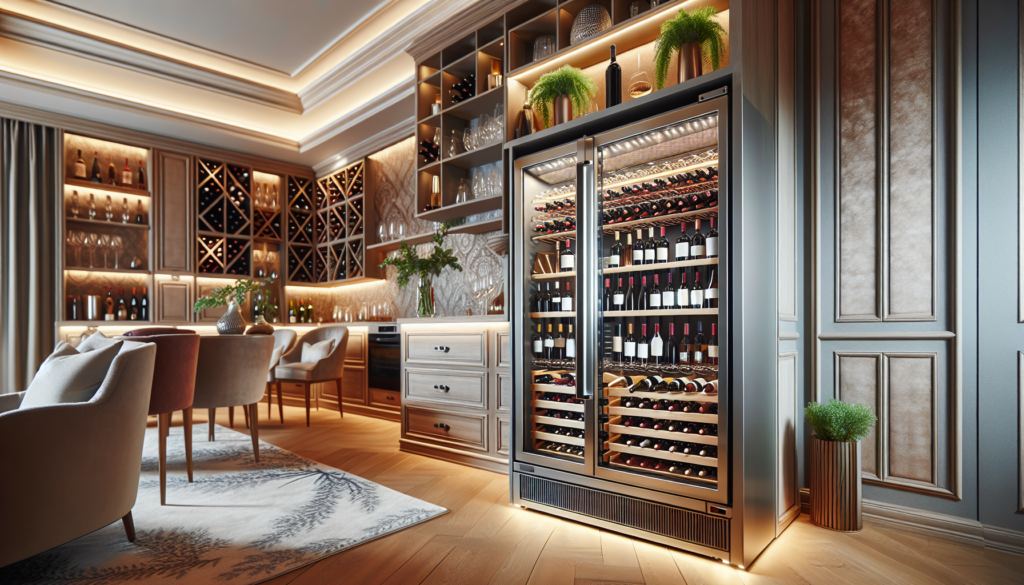Thinking about adding a touch of sophistication to your home? Look no further than wine fridge installation. With its sleek design and ability to keep your favorite bottles at the perfect temperature, a wine fridge is a must-have for any wine enthusiast. Whether you’re a seasoned collector or just starting to explore the world of wine, having a dedicated space to store and showcase your bottles is a game-changer. In this article, we will guide you through the process of wine fridge installation, providing you with all the tips and tricks you need to create your very own wine oasis. Get ready to elevate your wine experience to a whole new level!

Selecting a Wine Fridge
Determining your needs
When selecting a wine fridge, it’s important to consider your specific needs. Are you a casual wine drinker or a serious collector? Do you prefer red or white wines, or both? How many bottles do you typically have on hand? Understanding your needs will help narrow down your options.
Considering the available space
Before purchasing a wine fridge, it’s crucial to assess the available space in your home. Measure the height, width, and depth of the area where you plan to install the fridge. Keep in mind that the fridge will require some clearance for ventilation.
Choosing the right size
With the information about your available space in hand, you can now choose the right size of wine fridge. Consider both the external dimensions and the internal storage capacity. Make sure the fridge will fit comfortably in your desired location while still accommodating your wine collection.
Deciding on the capacity
The capacity of the wine fridge refers to the number of bottles it can hold. Depending on the size of your collection, you will need to decide whether a smaller capacity fridge will suffice or if a larger one is necessary. Keep in mind that you may want to leave room for future additions to your collection.
Opting for a single or dual zone fridge
Wine fridges often come with either single-zone or dual-zone cooling options. Single-zone fridges maintain a consistent temperature throughout, which is suitable for most red and white wines. Dual-zone fridges have separate compartments with different temperature settings, allowing you to store different types of wines properly.
Preparing for the Installation
Finding the ideal location
Choosing the right location for your wine fridge is essential for optimal performance and convenience. Consider placing it in a cool, well-ventilated area away from direct sunlight and heat sources. Basements, closets, or areas with controlled temperature are often good options.
Ensuring adequate ventilation
Proper ventilation is crucial for your wine fridge. Ensure that there is enough space behind and around the fridge to allow air circulation. A lack of ventilation can lead to overheating and potential damage to the fridge.
Checking the power supply
Before installation, make sure that the power supply near the chosen location is sufficient. Check if there are available electrical outlets nearby or if you will need to use an extension cord. It’s important to follow the manufacturer’s guidelines regarding the recommended power supply for your fridge.
Considering temperature fluctuations
Temperature fluctuations can adversely affect the quality of your wines. Avoid placing the fridge near appliances that generate heat, such as ovens or radiators. Consider the stability of the chosen location’s temperature throughout the day to minimize temperature variations.
Removing obstacles and hazards
To ensure safety during installation and for the proper operation of the fridge, remove any obstacles or hazards in the chosen location. Clear the area of any debris, fragile objects, or items that may potentially obstruct the fridge or its ventilation.
Gathering Necessary Tools and Materials
Measuring tape
A measuring tape will help you accurately measure the available space for your wine fridge.
Level
A level is essential to ensure that your wine fridge is installed properly and is not tilted.
Screwdriver
A screwdriver will be needed for attaching any required accessories and securing the fridge.
Power drill
A power drill may be necessary for certain installations that require mounting or making holes.
Stud finder
If you plan to secure your wine fridge to the wall or a cabinet, a stud finder can help locate the studs for added stability.
Wood shims
Wood shims can help level the fridge if the floor is not perfectly even.
Electrical tape
Electrical tape is useful for securing and organizing any loose wires or cords during installation.
Extension cord
An extension cord may be required if the chosen location is not near an accessible electrical outlet.
Installing the Wine Fridge
Unpacking the fridge
Carefully unpack your wine fridge and remove any internal packaging materials or protective coatings.
Removing internal packaging
Inspect the interior of the fridge for any removable packaging items, such as foam or tape, that could obstruct the proper functioning of the fridge.
Attaching any required accessories
If your wine fridge comes with accessories such as shelves or wine racks, follow the manufacturer’s instructions to attach them properly.
Positioning the fridge
Move the fridge to its designated location, ensuring there is sufficient clearance for the door to open fully and for easy access to the bottles.
Securing the fridge to the wall or cabinet
If desired or recommended by the manufacturer, secure the wine fridge to the wall or cabinet using appropriate hardware. This will provide added stability and prevent accidental tipping.
Connecting to the power supply
Plug the wine fridge into an accessible and grounded electrical outlet. If an extension cord is required, ensure it is suitable for the appliance’s power requirements.
Adjusting the leveling legs
Use a level to ensure that the fridge is properly balanced. Adjust the leveling legs accordingly to achieve a stable and level position.
Installing the door handle
If the wine fridge comes with a separate door handle, follow the instructions to install it securely.
Testing the fridge
Once the installation is complete, test the functionality of the wine fridge. Check if it is cooling properly and if all features, such as temperature control, are working as intended.

Ensuring Proper Usage and Maintenance
Setting the temperature
After installation, set the temperature of the wine fridge according to the recommendations for the type of wine you are storing. Refer to the manufacturer’s guidelines for the optimal temperature range.
Stocking the fridge
Start stocking your wine fridge with your preferred bottles. Consider organizing them by type, region, or age to have easy access to your collection.
Organizing the bottles
To maximize space and maintain organization, arrange the bottles in a way that allows for easy visibility and retrieval. Consider using wine racks or dividers to help keep the bottles neatly organized.
Monitoring humidity levels
Maintaining consistent humidity levels is crucial for the proper storage of wines. Regularly check the humidity levels and use appropriate measures, such as a hygrometer or humidity control packs, to keep the humidity within the recommended range.
Cleaning the fridge regularly
Regular cleaning of your wine fridge is necessary to prevent the buildup of dust, debris, and unwanted odors. Follow the manufacturer’s instructions on how to properly clean the interior and exterior of the fridge.
Replacing filters and gaskets
If your wine fridge has filters or gaskets, regularly check and replace them as needed. This ensures optimal performance and prevents any potential issues caused by clogged filters or damaged gaskets.
Inspecting for leaks
Periodically inspect your wine fridge for any signs of leaks or condensation buildup. If you notice any leaks, address them promptly to prevent damage to the fridge or your wine collection.
Tracing power issues
If you experience any power-related issues with your wine fridge, such as frequent tripping of the circuit breaker, consult the user manual or contact a professional for assistance. Electrical issues should be addressed promptly to ensure safe operation.
Seeking professional assistance when needed
For any complex installations, repairs, or troubleshooting, it is always advisable to seek professional assistance. They have the expertise and knowledge to handle more technical aspects and ensure safe and proper operation.
Troubleshooting Common Issues
Unusual noises
If your wine fridge is producing unusual noises, such as loud humming or rattling sounds, it may indicate a problem with the compressor, fan motor, or other internal components. Contact a professional technician to diagnose and resolve the issue.
Inaccurate temperature readings
If you notice inconsistent or inaccurate temperature readings on your wine fridge, it may be a sign of a malfunctioning thermostat or temperature sensor. Consult the user manual or contact the manufacturer for guidance on recalibration or repairs.
Fridge not cooling properly
If your wine fridge is not cooling to the set temperature or maintaining a consistent temperature, it may indicate a problem with the cooling system, such as a faulty compressor or refrigerant leak. Contact a professional technician to assess and repair the issue.
Condensation buildup
Excessive condensation inside the wine fridge can lead to mold growth and potential damage to your wine bottles. Ensure that the fridge’s door seal is intact and remains clean. If condensation issues persist, consult a professional for further investigation.
Excessive vibration
Excessive vibration can negatively impact the quality and aging process of your wines. Check if the wine fridge is securely placed and level. If the vibration continues, it may indicate an issue with the internal components, such as a malfunctioning compressor or fan motor. Seek professional assistance to address the problem.
Electrical problems
If you experience any electrical problems with your wine fridge, such as power failure or malfunctions in the control panel, it is crucial to address them immediately. Consult a professional technician or contact the manufacturer for guidance on resolving electrical issues.
Safety Considerations
Following manufacturer instructions
Always closely follow the manufacturer’s instructions during the installation, usage, and maintenance of your wine fridge to ensure safe and proper operation.
Avoiding overloading the fridge
Do not exceed the recommended storage capacity of your wine fridge. Overloading the fridge can impact its performance, compromise airflow, and potentially damage the stored wines.
Monitoring carbon monoxide levels
If your wine fridge is located in an enclosed area, such as a small closet or basement, it is essential to monitor carbon monoxide levels. Use appropriate carbon monoxide detectors to ensure the safety of the environment and prevent any potential health risks.
Taking precautions during power outages
During power outages, it’s crucial to take precautions to protect your wine collection. Avoid opening the wine fridge unnecessarily to minimize temperature fluctuations. Consider using backup power sources, such as battery-powered coolers, to maintain proper storage conditions.
Keeping children and pets away
Ensure that your wine fridge is installed in an area inaccessible to children and pets. This prevents accidents, damage to the fridge, and potential harm to individuals.
Properly disposing of packaging materials
Dispose of any packaging materials according to local regulations. Recycling or properly disposing of packaging materials helps minimize environmental impact and promotes sustainable practices.
Benefits of Wine Fridges
Preserving the quality of wines
Wine fridges are specifically designed to provide the optimal storage conditions needed to preserve the quality and taste of wines. They control temperature and humidity levels, protecting your investment.
Providing ideal storage conditions
Wine fridges create a stable environment with consistent temperature and humidity, which are crucial for the proper aging and preservation of wines. These conditions help maintain the desired flavor, aroma, and overall quality of the wines.
Allowing aging and maturation
Wine fridges provide the opportunity to age and mature wines in a controlled environment. With the ability to set precise temperatures, you can create the ideal conditions for long-term aging and optimal maturation of the wines.
Organizing wine collection
A wine fridge allows you to organize your wine collection efficiently. With designated spaces for different types of wines, you can easily locate and access the bottles you desire without disturbing others.
Space-saving and aesthetic appeal
Wine fridges are often designed to be compact and fit seamlessly into various spaces in your home. They not only save space but also enhance the aesthetic appeal of your living area, kitchen, or cellar.
Common Mistakes to Avoid
Installing in unsuitable locations
Avoid installing your wine fridge in areas that are unsuitable for proper storage conditions, such as near heat sources or in direct sunlight. Choose a location that provides consistent temperature and humidity levels.
Neglecting proper leveling
Proper leveling is crucial for the correct operation of your wine fridge. Failing to level the appliance can cause imbalances, vibration, and potential damage over time. Use a level to ensure it is properly balanced.
Overlooking power supply requirements
Ensure that the chosen location for your wine fridge has a suitable power supply. Neglecting power supply requirements can lead to electrical issues or performance problems.
Ignoring regular maintenance
Regular maintenance is essential for the long-term functionality and lifespan of your wine fridge. Ignoring maintenance tasks, such as cleaning, filter replacements, and inspections, can result in decreased performance and potential damage.
Failing to read the user manual
The user manual provides valuable information on installation, usage, maintenance, and troubleshooting specific to your wine fridge model. Failing to read the user manual can lead to errors or improperly operating the appliance.
Conclusion
Selecting and installing a wine fridge requires careful consideration of your needs and available space. Proper installation, maintenance, and usage are vital to ensure the optimal storage conditions for your wine collection. By following the guidelines outlined in this article, you can enjoy the benefits of a wine fridge while preserving the quality of your wines for years to come.
